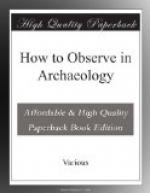Stylized plant motifs in decoration. Rays (or flower petals) rising from foot most characteristic (III, Figs. 24, 26, and 28).
Use of purple paint to supplement black both for details of figures and for band decoration.
Geometric ornament (though perhaps with a difference) survives to fill blank spaces on backgrounds of scenes.
Varieties of style. Beasts drawn in silhouette, heads outlined, eyes, &c., drawn in, early, and mainly in the islands (III, Fig. 29). Later whole figures in silhouette with details incised, particularly identified with Corinthian and Boeotian and Laconian styles (III, Fig. 26). Styles most likely to be found on the mainland are ’Proto-Corinthian’ and ‘Corinthian’.
‘Proto-Corinthian’ (also called Argive Linear). Small vases, very fine pale clay. Decoration chiefly horizontal lines very fine. Rays from feet. Sometimes silhouette animals round shoulder.
Characteristic shapes: pear-shaped aryballoi, and lekythi with conical body, long neck, and trefoil lip (III, Figs. 24 and 25).
‘Corinthian’. Clay pale buff to warm biscuit colour. Rays round foot. Purple bands. Rows of usual animals. Incisions. Details in purple. Ground ornaments, incised rosettes more or less carefully drawn. These in great profusion leaving very little bare space. (III, Fig. 26; hatched lines=purple.) Throughout this period desire for a light ground was felt, and where the natural colour of the clay did not give sufficient contrast it was covered with a strip of cream-or white clay (e.g. Rhodian, Naucratite, Laconian; see III, Fig. 28, Early Laconian Vase).
Terra-cotta Figurines. Series that culminates with Tanagra figures of fourth century begins. May be said always to be a step in advance of contemporary sculpture if any.
Statuettes rare at this date, but relief heads on flat plaques or on vase handles common. Treatment of hair usually resembles Restoration wig (III, Fig. 20). Rosette frequent on shoulders represents head of bronze (rarely silver or gold) shoulder pin.
Bronzes. Pins (to fasten dress at shoulder). Three large bosses increasing in size as they near head replace many small equal bosses of preceding period. Disc heavier (III, Fig. 22).
Brooches. Spiral type has disappeared. Couchant lion type with snake tail has been found at Olympia and Sparta. In general brooches cease to be common.
Plaques (doubtless affixed to wood). Relief patterns of guilloches or rows of bosses. Figure scenes similar to those on pottery. Characteristic of seventh century. Chance of picking up slight.
Inscriptions. Earliest extant examples of use of Greek script on stone may date from this period. For developments, see tables of alphabets, Illustration IV.
[Illustration IV: Greek alphabets]
B. Black Figured Period.
600 B.C.—Predominance of Attic pottery. Decay of local styles. Introduction of red colouring into clay and of superlative Attic black glaze.




